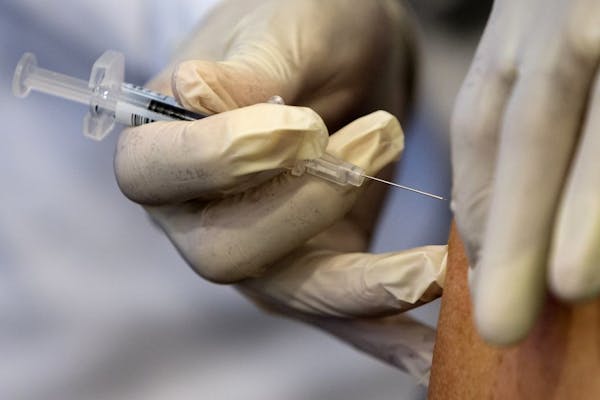Ten Bloomington elementary schools will offer free "smart" thermometers to families this fall in the hope that online reporting of fevers will provide early warnings of illnesses and infections circulating among students.
The program is one of the latest to use crowdsourcing — the tracking of consumer input on search engines, social media or mobile apps — to improve public health.
The idea is that aggregate temperature data, synced from the thermometers to mobile phone apps, can alert parents and schools to emerging infectious outbreaks, while advising parents what to do when their children suffer fevers and other symptoms, said Julie Campanelli, chairwoman of the Bloomington district's wellness committee.
"Parents with a sick child are able to see that 'Oops, it looks like this could be flu' " based on the number of classmates with fevers, she said. " 'Maybe I should keep my kid home so I'm not exposing everybody.' "
Crowdsourcing has emerged in health care over the past decade as researchers tried to predict illness patterns by analyzing terms that consumers enter into search engines such as Google or sickness information logged by large numbers of consumers into apps such as Flu Near You.
While skeptics have raised concerns about the reliability and privacy of the strategy, one study this June found 285 scholarly articles about efforts to use crowdsourcing to improve everything from disease surveillance to nutrition to symptom diagnosis.
San Francisco-based Kinsa Inc. sells its digital smart thermometers, which upload temperature information anonymously to a reporting system, and donates them to schools through its FLUency program.
Bloomington is the first Twin Cities district to use them; Minnesota schools in Cloquet, Sebeka and Prinsburg have tried them already.
Early warnings are important for influenza because drugs such as Tamiflu shorten the course of illness only if taken within the first two days of infection, said Nita Nehru, who directs FLUency. The donation program is supported by Lysol, one of the companies that advertises on the Kinsa app.
"Our mission is to help track and stop the spread of illness by knowing more about where and when it is spreading," Nehru said. "More information on what's going around enables you to make better decisions for your family."
The Kinsa app also gives parents medical advice based on the temperature readings and symptoms they report.
Crowdsourcing had an inauspicious start in health care when Google shuttered its Flu Trends program, which attempted to predict influenza activity based on search engine patterns. The program missed the peak of the 2013-2014 flu season, reportedly because it didn't adapt to changes in search habits and terminology.
Studies continue to validate crowdsourcing, though. University of Iowa researchers conducted simulations using three years' worth of Kinsa thermometer data and determined that they could forecast spikes in the flu season ahead of official outbreak reports from the U.S. Centers for Disease Control and Prevention.
"Typically, an influenza outbreak lasts 16 weeks, but 16 weeks can start as early as November and as late as March," said Aaron Miller, one of the Iowa researchers. "Knowing when that is happening is important."
Iowa researchers were among the first a decade ago to try predicting the flu season based on Yahoo! search activity, and they are testing whether responses on Twitter and Wikipedia can yield meaningful health warnings as well.
Miller said there is some evidence that surges in the use of smart thermometers predict the start of flu seasons, regardless of the temperature readings they produce, because people don't use them until they have symptoms.
Privacy advocates have raised concerns, even though participants submit their health information voluntarily.
Bloomington parents using Kinsa will be able to see only the number of children in their schools or grades that have colds or flu symptoms or sore throats.
School nurses will see districtwide data but no student-specific information.
Nehru said Kinsa doesn't even collect identifying information, only the temperature and symptom data along with rough geographic locations of the users.
Users of crowdsourcing health care apps such as Kinsa should take steps to learn where their data goes and how long it is stored, said Twila Brase of the Citizens' Council for Health Freedom, a St. Paul-based advocate for health care privacy.
"People just think, 'Oh, cool app!' And they don't go any further," Brase said.
While several crowdsourcing health care apps have failed, the successful ones tend to provide information faster than traditional means or data that can't be found elsewhere, said Clark Freifeld, a data analytics and crowdsourcing researcher at Northeastern University.
One example is StreetRx, a controversial app listing black-market prices of prescription and illicit drugs.
Crowdsourcing won't replace traditional disease surveillance, but it might catch infections that are otherwise missed, said Karen Green Martin, a senior epidemiologist with the Minnesota Department of Health. The department has launched a partnership with Flu Near You in which it will send swab kits to Minnesotans who use the flu app so they can send in samples for flu testing.
"It's getting at those people who are sick but might not go to the doctor," she said.
The state already tracks outbreaks of influenza-like illness in schools based on absentee numbers, but the Kinsa school program could help with early warnings, Martin said.
"I'm very curious to see how that works," she said. "There's definitely some room to help fill in these surveillance gaps."
Jeremy Olson • 612-673-7744

Four Minnesotans catch salmonella in outbreak linked to basil sold at Trader Joe's

Rep. Omar's daughter arrested, suspended from college for pro-Palestinian protests
Hopkins parents charged in 9-year-old daughter's asthma death

Back to blue: Lake Harriet Band Shell renovation almost finished

